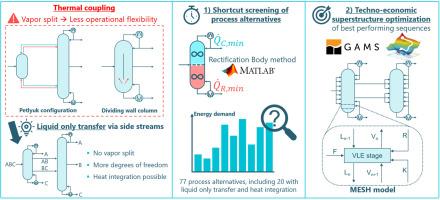超越分隔墙柱:通过仅液体传递和热集成提高工艺强度
IF 3.9
3区 工程技术
Q3 ENERGY & FUELS
Chemical Engineering and Processing - Process Intensification
Pub Date : 2025-09-18
DOI:10.1016/j.cep.2025.110559
引用次数: 0
摘要
许多化工公司的目标是到2050年实现气候中和,这需要改变原材料,并大幅减少加工能耗。由于蒸馏占能源使用的很大一部分,它是工艺改进的关键目标。一种有前途的方法是柱间的热耦合,这已经在工业上实现了,特别是在分隔墙柱。然而,由于平行段之间固定的蒸汽分裂,这种配置往往受到操作灵活性的限制,这在设计时基本上是固定的,在操作过程中很难调整。通过将每个双向汽液连接替换为仅液体传输的侧流,可以克服这一限制。这个概念允许每个柱在单独的压力下运行,并为热集成提供了新的选择。本研究介绍了一种结构化的方法,用于评估和优化具有一个或两个纯液体传输侧流的系统,特别是当与直接热集成相结合时。首先通过高效的捷径筛选确定有希望的配置,然后通过上部结构优化进一步优化。对分离苯、甲苯和对二甲苯的案例研究表明,直接热集成的纯液体传递配置可以显著降低能源和成本,在许多情况下优于传统的热耦合系统。本文章由计算机程序翻译,如有差异,请以英文原文为准。

Beyond dividing wall columns: Improved process intensification through liquid-only transfer and heat integration
Many chemical companies aim to achieve climate neutrality by 2050, requiring raw material changes and significant reductions in process energy. Since distillation accounts for a large share of energy use, it is a key target for process improvements. One promising approach is thermal coupling between columns, which is already industrially implemented, especially in dividing wall columns. However, such configurations often suffer from limited operational flexibility due to the fixed vapor split between parallel sections, which is largely fixed during design and difficult to adjust during operation. This limitation can be overcome by replacing each bidirectional vapor-and-liquid connection with a liquid-only transfer side stream. This concept allows each column to operate at an individual pressure and enables new options for heat integration. The present study introduces a structured approach for assessing and optimizing such systems with one or two liquid-only transfer side streams, particularly when combined with direct heat integration. Promising configurations are first identified through an efficient shortcut screening and can further be optimized using superstructure optimization. A case study on separating benzene, toluene, and para-xylene demonstrates that liquid-only transfer configurations with direct heat integration can significantly reduce energy and costs, and in many cases outperform conventional thermally coupled systems.
求助全文
通过发布文献求助,成功后即可免费获取论文全文。
去求助
来源期刊
CiteScore
7.80
自引率
9.30%
发文量
408
审稿时长
49 days
期刊介绍:
Chemical Engineering and Processing: Process Intensification is intended for practicing researchers in industry and academia, working in the field of Process Engineering and related to the subject of Process Intensification.Articles published in the Journal demonstrate how novel discoveries, developments and theories in the field of Process Engineering and in particular Process Intensification may be used for analysis and design of innovative equipment and processing methods with substantially improved sustainability, efficiency and environmental performance.

 求助内容:
求助内容: 应助结果提醒方式:
应助结果提醒方式:


